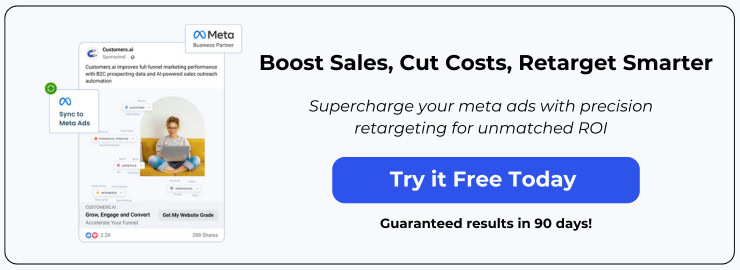Brands face fierce competition for consumer attention these days.
With so many potential touchpoints across websites, apps, and ads, it’s all too easy for promising leads to get lost or abandon their journey.
That’s where retargeting comes in – the strategic practice of re-engaging these dormant prospects.
But traditional retargeting methods are quickly becoming outdated. To truly maximize audience recovery and unlock new revenue, savvy marketers are turning to AI-powered solutions.
The Missed Opportunity of Abandoned Audiences
Think about the immense effort brands invest to drive traffic and capture leads.
From search engine optimization and paid advertising to email marketing and social media – serious time and money goes into filling the sales funnel.
So when interested prospects bounce before converting, it represents a massive missed opportunity.
Data from the Baymard Institute reveals the average online shopping cart abandonment rate is an astonishing 69.8%. And that’s just for ecommerce – the figure is likely even higher for lead captures, content downloads, and other conversion goals across industries.
All those abandoned audiences equate to potential revenue simply vanishing.
Traditional retargeting tactics like banner ads can recover some lost users, but these methods are too scattershot.
They waste impressions on irrelevant audiences while failing to deliver the right message via the right channel at the ideal moment.
This one-size-fits-all approach leaves revenue on the table. AI-powered retargeting unlocks a smarter, data-driven approach to audience recovery.
How AI Revitalizes Retargeting Campaigns
By leveraging advanced machine learning algorithms, AI tools can analyze a brand’s historical data – including customer journeys, campaign performance metrics, and granular audience behavior patterns across channels.
This deep learning surfaces valuable insights that power:
Intelligent Audience Segmentation
Rather than lumping all lost leads into catchall “abandoned” segments, AI can slice audiences with precision based on variables like:
- Funnel stage (e.g. cart abandoners vs. lead form exits)
- Engagement level (e.g. frequent visitors vs. one-and-dones)
- Demographic and psychographic traits
- Observed purchase intent signals
With laser-focused segmentation, brands can deploy hyperpersonalized retargeting flows tailored to each micro-audience’s unique needs and mindset.
Dynamic Creative Optimization
Generic banner ads promote tune-out and wasted ad spend. AI dynamically optimizes the creative assets and messaging served to individual users based on their:
- Observed behavior patterns
- Historical interactions with the brand
- Predicted interests and purchase intent
This ensures the perfect attention-grabbing ad creative and call-to-action is delivered for maximum re-engagement.
Omnichannel Orchestration
In the modern age, effective retargeting requires more than just display ads. AI enables true cross-channel coordination by automatically:
- Mapping unified user journeys across devices and touchpoints
- Identifying the ideal channel mix and cadence for each audience segment
- Triggering real-time, behavior-driven campaigns via web, mobile, social, email, SMS, and more
This unified approach prevents disjointed, siloed experiences that frustrate today’s omnichannel consumers.
Continuous Optimization
AI isn’t a set-it-and-forget-it solution. Machine learning models continuously ingest fresh data signals, quickly detecting shifts in audience behavior, market dynamics, and more. This allows for agile optimization of:
- Audience segmentation logic
- Channel mix and creative strategy
- Bid tactics and budget allocation
The result? Retargeting programs that stay hyperpersonalized, high-performing, and cost-efficient over time.
Key Takeaways
In an era of infinite consumer choice and fleeting attention, brands can’t just acquire new customers – they must obsess over re-engaging lost leads and lapsed buyers. By applying advanced AI and machine learning, forward-thinking marketers can:
- Uncover granular audience insights that power intelligent segmentation
- Dynamically optimize messaging and delivery channels for each user
- Orchestrate seamless omnichannel retargeting at scale
- Continuously refine and enhance their audience recovery strategies
With AI’s intelligent automation and predictive capabilities, brands can transform retargeting from an afterthought into a core competitive advantage – stopping revenue leakage and maximizing lifetime customer value.
FAQs
-
What is AI retargeting and how does it differ from traditional retargeting?
AI retargeting uses machine learning to analyze audience data and automatically optimize retargeting campaigns, unlike traditional methods that rely on manual rules and segmentation. -
How can AI improve audience segmentation for retargeting campaigns?
AI can slice audiences into granular segments based on variables like funnel stage, engagement level, psychographics, and purchase intent signals for hyperpersonalized retargeting. -
What is dynamic creative optimization for retargeting?
Dynamic creative optimization uses AI to automatically serve the perfect ad creative and messaging to each user based on their unique behavior patterns and predicted interests. -
Can AI really orchestrate true omnichannel retargeting campaigns?
Yes, AI maps user journeys across channels and devices, identifies the ideal channel mix and cadence for each segment, and triggers real-time campaigns via web, mobile, social, email, SMS, etc. -
How does AI enable continuous optimization of retargeting strategies?
AI models continuously analyze fresh audience data to quickly detect shifts in behavior and market conditions, allowing for agile optimization of segmentation, channels, creative, and more. -
What are the benefits of using AI for retargeting over traditional methods?
AI retargeting enables smarter segmentation, dynamic ad optimization, coordinated omnichannel execution, and continuous enhancement for maximizing re-engagement and ROI. -
How can AI retargeting help recover abandoned shopping carts and leads?
By leveraging machine learning insights, AI retargeting deploys hyperpersonalized, cross-channel campaigns triggered by cart abandons and other high-intent behaviors. -
Is AI retargeting suitable for B2B brands and lead generation campaigns?
Absolutely, AI retargeting applies to any marketing use case involving re-engaging lost prospects and can be tailored based on B2B buyer journeys and lead qualifications. -
What data is required to utilize AI for retargeting campaigns?
AI retargeting models are trained on historical first-party data such as customer journeys, campaign performance, audience behaviors, transactions, and more. -
How can marketers get started with implementing AI retargeting?
Many leading marketing clouds and retargeting platforms now offer AI-powered audience recovery solutions that integrate seamlessly with existing martech stacks.

